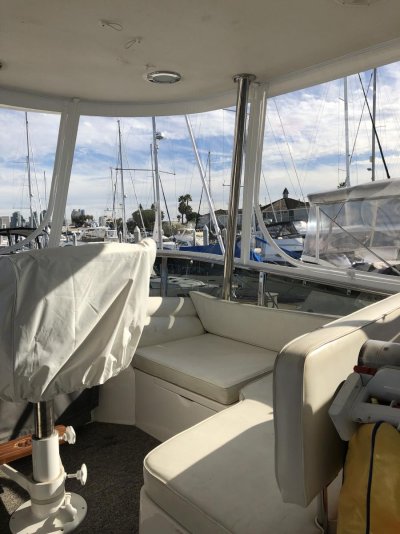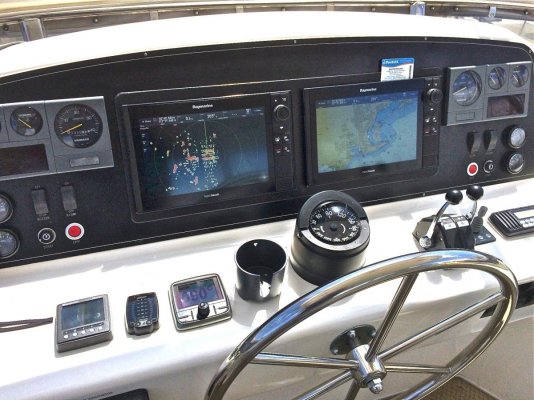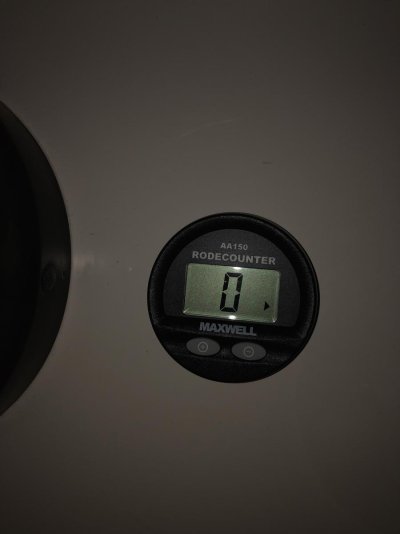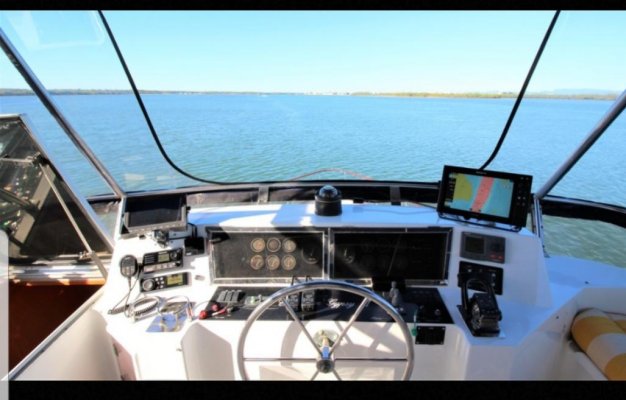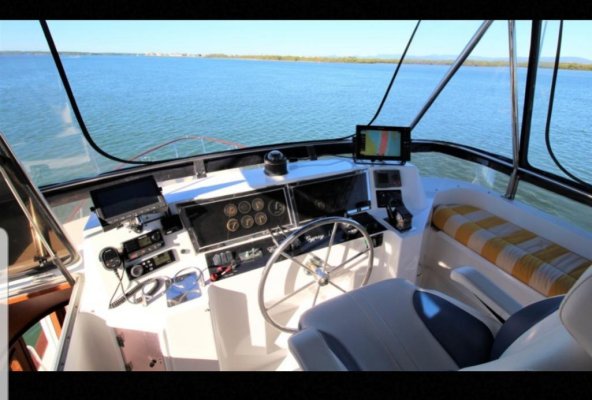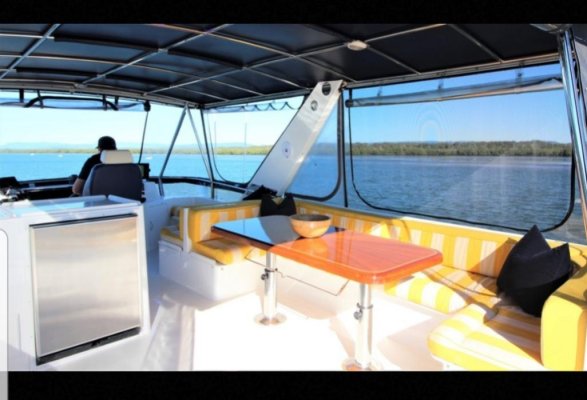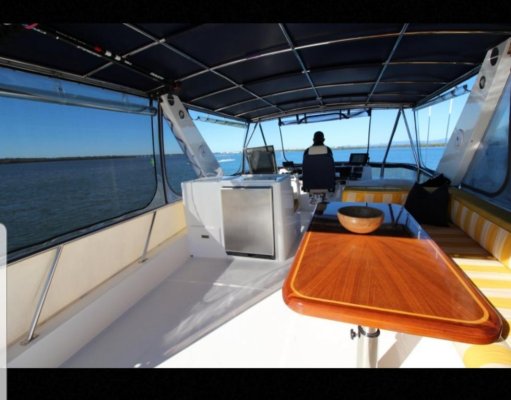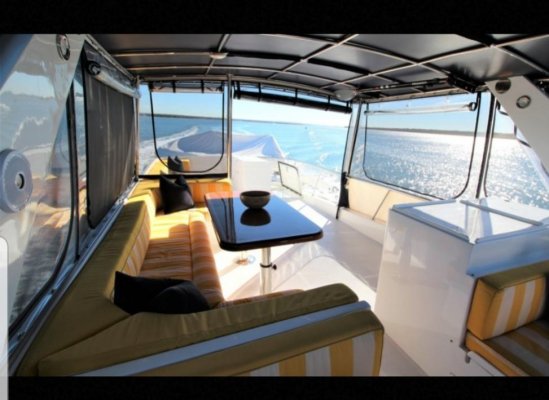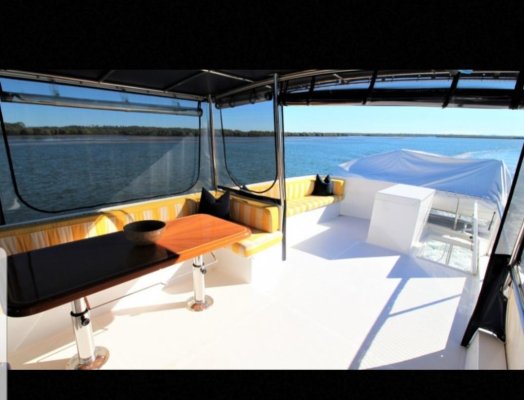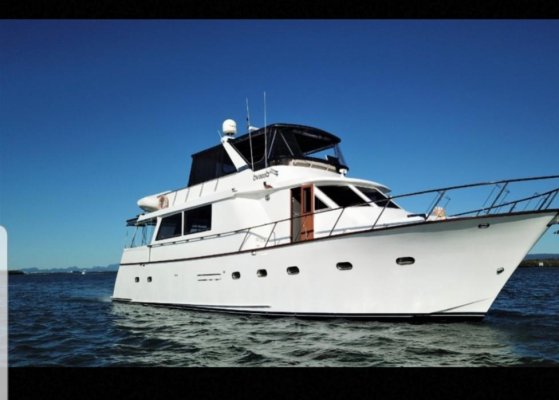63 ft apparent long range cruiser with only a flybridge helm, enclosable with clears. My thinking is, that I worry about cruising in foul weather from a flybridge for extended lenghts of time with limited viability through wet clears. Guests/ family are on the main deck due to the weather and accentuated rolling that you get from being high up. What experiences, preference do people have. Any so called long range cruisers that I have seen seem to mostly have either a dual helm or just a lower one. Any thoughts??
You are using an out of date browser. It may not display this or other websites correctly.
You should upgrade or use an alternative browser.
You should upgrade or use an alternative browser.
Flybridge helm only ??
- Thread starter Ralsy
- Start date
The friendliest place on the web for anyone who enjoys boating.
If you have answers, please help by responding to the unanswered posts.
If you have answers, please help by responding to the unanswered posts.
tiltrider1
Guru
- Joined
- Aug 2, 2017
- Messages
- 4,344
- Location
- Pacific North West
- Vessel Name
- AZZURRA
- Vessel Make
- Ocean Alexander 54
I have a dual helm. My flybridge is enclosed with canvas and vinyl. Oddly, I spend almost 100% of my time in the upper helm. You would think that in big seas the motion would send me down but it has not. I have done Coastal Cruising, running around the clock some 25 miles off shore. What I have not done is a passage. How would I feel running 24/7 from my flybridge? My gut says no, I wouldn’t want a passage maker with out the lower helm.
So, in other words I feel the same as you but just maybe the reality is different or at least different for different folks.
So, in other words I feel the same as you but just maybe the reality is different or at least different for different folks.
63 ft apparent long range cruiser with only a flybridge helm, enclosable with clears. My thinking is, that I worry about cruising in foul weather from a flybridge for extended lenghts of time with limited viability through wet clears. Guests/ family are on the main deck due to the weather and accentuated rolling that you get from being high up. What experiences, preference do people have. Any so called long range cruisers that I have seen seem to mostly have either a dual helm or just a lower one. Any thoughts??
The considerations you list are valid, and I would add this: when shorthanded and faced with the necessity to handle a dock line, pick up a mooring, or recover someone / something in the water alongside the boat, it's awkward for the helmsman to leave a flybridge station, scamper down a ladder to the cockpit and help on the main deck. Much better to have a helm station on deck, preferably with a side door opening onto the side deck / walkway. From there, the person on the helm can disengage the engine and step away from the wheel to be helpful for a few moments.
Will mostly be coastal cruising with maybe the longest passage of maybe 18 hours at 9 knots. Will have a second person on board for most trips (wife). How's the visability with clears when it's raining and you are trying to dock?
jleonard
Guru
- Joined
- Jun 25, 2008
- Messages
- 5,063
Will mostly be coastal cruising with maybe the longest passage of maybe 18 hours at 9 knots. Will have a second person on board for most trips (wife). How's the visability with clears when it's raining and you are trying to dock?
I never had an issue with visibility from the bridge
psneeld
Guru
Will mostly be coastal cruising with maybe the longest passage of maybe 18 hours at 9 knots. Will have a second person on board for most trips (wife). How's the visability with clears when it's raining and you are trying to dock?
I have run a lot of different boats and unless you have certain "clears"...visibiity can be awful to dangerous.
Of course docking from a lower station can be challenging because of lack of view and rain can make any docking tough.
A second station is only as useful as it is instrumented...
No right answer...only "it depends" on the boat and partially the captain.
tiltrider1
Guru
- Joined
- Aug 2, 2017
- Messages
- 4,344
- Location
- Pacific North West
- Vessel Name
- AZZURRA
- Vessel Make
- Ocean Alexander 54
Will mostly be coastal cruising with maybe the longest passage of maybe 18 hours at 9 knots. Will have a second person on board for most trips (wife). How's the visability with clears when it's raining and you are trying to dock?
Visibility through wet vinyl is better than constant spray on the lower helm. For docking, wet vinyl and wet glass is pretty equal. A good defogging system is important. My flybridge actually has better defogging than my lower helm.
Comodave
Moderator Emeritus
- Joined
- Jul 2, 2015
- Messages
- 21,283
- Location
- Au Gres, MI
- Vessel Name
- Black Dog
- Vessel Make
- Formula 41PC
I would think that a 63’ boat would have stabilizers. We only have a flybridge helm, we didn’t want a lower helm because of the space given up. So we always drive from the bridge.
As to visibility from the flybridge with eisenglass in the rain. We have EZ2CY for our front panels. I was told by a canvas guy in NJ that fabricated the EZ2CY panels that I should use Sumner 210 spray wax on them and it would help the water bead and roll off. I had polished the old panels that came with the boat and were pretty cloudy for hours with a lot of different products including Flitz and used a buff ball for hours. I had given up on making them better for the trip home. He gave me a can of 210 and I used it. The difference was phenomenal and it is easy and quick to use. Literally I had spent 5 hours buffing the panels with Flitz and a buff ball on a drill. I used the 210 and did the inside and outside of the flybridge and sundeck enclosures in 1.5 hours. It is all I use on my panels now. Love the 210. No affiliation.
As to visibility from the flybridge with eisenglass in the rain. We have EZ2CY for our front panels. I was told by a canvas guy in NJ that fabricated the EZ2CY panels that I should use Sumner 210 spray wax on them and it would help the water bead and roll off. I had polished the old panels that came with the boat and were pretty cloudy for hours with a lot of different products including Flitz and used a buff ball for hours. I had given up on making them better for the trip home. He gave me a can of 210 and I used it. The difference was phenomenal and it is easy and quick to use. Literally I had spent 5 hours buffing the panels with Flitz and a buff ball on a drill. I used the 210 and did the inside and outside of the flybridge and sundeck enclosures in 1.5 hours. It is all I use on my panels now. Love the 210. No affiliation.
psneeld
Guru
Actually constant spray with wipers is better than very intermittent spray where the liquid dries to a salt film.
And I think a lot of people are assuming the very good or new vinyl.
The vast majority of boats I have been on the bridge vinyl is already cloudy enough to run with it open under ideal conditions.
Keep it new like or go with one of the newer miracle vinyls and sure...different story.
So bottom line is that a flybridge only is no big deal except maybe for line handling if it is laid out well, instrumented well and the enclosure stays glasslike.
And I think a lot of people are assuming the very good or new vinyl.
The vast majority of boats I have been on the bridge vinyl is already cloudy enough to run with it open under ideal conditions.
Keep it new like or go with one of the newer miracle vinyls and sure...different story.
So bottom line is that a flybridge only is no big deal except maybe for line handling if it is laid out well, instrumented well and the enclosure stays glasslike.
Comodave
Moderator Emeritus
- Joined
- Jul 2, 2015
- Messages
- 21,283
- Location
- Au Gres, MI
- Vessel Name
- Black Dog
- Vessel Make
- Formula 41PC
I did add a stern thruster since we only have the upper helm. Our dog has to be first so it was always a race between him and I to get down from the flybridge first. With the stern thruster I can get down from the bridge carefully and then bump the stern back to the dock since most times it has blown off the dock by the time I could get down to handle the stern lines.
steelydon
Senior Member
When the sun goes down I move to the lower station. My instrumentation is actually better in the pilot house and the crew is kept is not allowed out on the decks or up top. It is a safety issue for us on overnight passages and while changing watches can be accomplished safely while underway knowing that everyone is within the confines of the boat is reassuring. If I am singlehanding with no dock assistance the lower helm is the only place to be. Access through both pilot house doors allows me to move easily on one level to handle lines. Wipers and climate control make the lower helm 100% more comfortable on winter/foul weather conditions. Also most crew and passengers move below so the lower helm keeps me in touch. The fridge and pantry are also easily accessible while at the lower helm. I would not own a boat without a lower helm.
rslifkin
Guru
- Joined
- Aug 20, 2019
- Messages
- 7,584
- Location
- USA
- Vessel Name
- Hour Glass
- Vessel Make
- Chris Craft 381 Catalina
I'll agree that only having an upper helm with vinyl windshields seems like a poor setup to me unless you only ever run in good weather and rarely take spray up that high.
I've only got an upper helm, but it's not as high up as most flybridges, so less of an issue with rolling comfort (by the time it gets too unpleasant, conditions are at the point where I'd rather be relaxing at the dock anyway). And unlike most flybridges, I've got real windshields with wipers (for better visibility), so between that, the bimini and the vinyl side curtains, it's protected enough from spray and weather provided it's not too cold.
With a flybridge, depending on air draft, whether there's already a radar arch, etc. you might be able to add proper windshields.
I've only got an upper helm, but it's not as high up as most flybridges, so less of an issue with rolling comfort (by the time it gets too unpleasant, conditions are at the point where I'd rather be relaxing at the dock anyway). And unlike most flybridges, I've got real windshields with wipers (for better visibility), so between that, the bimini and the vinyl side curtains, it's protected enough from spray and weather provided it's not too cold.
With a flybridge, depending on air draft, whether there's already a radar arch, etc. you might be able to add proper windshields.
tiltrider1
Guru
- Joined
- Aug 2, 2017
- Messages
- 4,344
- Location
- Pacific North West
- Vessel Name
- AZZURRA
- Vessel Make
- Ocean Alexander 54
Actually constant spray with wipers is better than very intermittent spray where the liquid dries to a salt film.
And I think a lot of people are assuming the very good or new vinyl.
The vast majority of boats I have been on the bridge vinyl is already cloudy enough to run with it open under ideal conditions.
Keep it new like or go with one of the newer miracle vinyls and sure...different story.
So bottom line is that a flybridge only is no big deal except maybe for line handling if it is laid out well, instrumented well and the enclosure stays glasslike.
Good points. I can’t imagine trying to operate while looking through old vinyl.
Comodave
Moderator Emeritus
- Joined
- Jul 2, 2015
- Messages
- 21,283
- Location
- Au Gres, MI
- Vessel Name
- Black Dog
- Vessel Make
- Formula 41PC
When we bought our current boat the vinyl was pretty cloudy. We planned on replacing all the canvas once we got the boat home. Met a canvas fabricator in NJ on the way home. He suggested EZ2CY for the forward panels. When I was making the new panels I sent him patterns for the front panels and he fabricated them for me. They are just like looking through glass. We clean and treat them and the vinyl panels with Sumner 210 spray wax which helps the water bead up and runoff without wipers. Works pretty well.
Codger2
Guru
- Joined
- Oct 11, 2007
- Messages
- 6,691
- Location
- US
- Vessel Name
- Circuit Breaker
- Vessel Make
- 2021..22' Duffy Cuddy cabin
Couldn't agree more! My helm is well equipped and flybridge only. The enclosure is .060 Lexan (polycarbonate), the windlass has a chain counter and is operated from the fly or the bow & the electronics are all Raymarine. (Radar, plotters, AIS, etc) but the VHFs are Standard Horizon with GPS & iCom with hailer, fog horn, etc. Note: The Lexan enclosure is new and sheds rain like I can't believe....hope this continues.So bottom line is that a flybridge only is no big deal except maybe for line handling if it is laid out well, instrumented well and the enclosure stays glasslike.

My only wish is that I had a "firemen's pole" for sliding down from the flybridge for line handling!

Attachments
Last edited:
Fletcher500
Guru
We are not long range cruisers, just the coastal thing. This is our first boat with both a lower and upper, and I have found both to be useful in different circumstances. The longest run we make is about 15 hours. When its cooler, or during the evening I prefer being inside the wheel house.
Medic
Senior Member
Think twice!
Will you have both heating and air conditioning on the flybridge? You state you will be mostly coastal cruising. Fine. Where? If on the East Coast above Florida, maybe OK. If Florida or the Bahamas or Caribbean, think hard. An enclosed flybridge with Eisinglass, Strataglass, EZ2CY or whatever in the hard sun is a greenhouse, and you must have air conditioning. Unless, of course, you can roll your panels, which you cannot do with EZ2CY, then you maybe, maybe will be OK.
If you are going to be inland in Kentucky, Tennessee, etc FORGET a non-air conditioned flybridge. Unless, of course, you have a second, inside helm in which case the flybridge will be wonderful on wonderful days.
Will you have both heating and air conditioning on the flybridge? You state you will be mostly coastal cruising. Fine. Where? If on the East Coast above Florida, maybe OK. If Florida or the Bahamas or Caribbean, think hard. An enclosed flybridge with Eisinglass, Strataglass, EZ2CY or whatever in the hard sun is a greenhouse, and you must have air conditioning. Unless, of course, you can roll your panels, which you cannot do with EZ2CY, then you maybe, maybe will be OK.
If you are going to be inland in Kentucky, Tennessee, etc FORGET a non-air conditioned flybridge. Unless, of course, you have a second, inside helm in which case the flybridge will be wonderful on wonderful days.
Comodave
Moderator Emeritus
- Joined
- Jul 2, 2015
- Messages
- 21,283
- Location
- Au Gres, MI
- Vessel Name
- Black Dog
- Vessel Make
- Formula 41PC
We only have an upper helm. We have EZ2CY on the front with a negative angle by design. When we put the hardtop on the bridge I made it so that the hardtop extended forward so the front panels angle back at the bottom. That helps keep a gentle rain off the front panels. But almost the entire width of the front hinges up to open the bridge and get as much air into the flybridge as we want. If it is cold we can run the genset and have a couple of space heaters up on the bridge. So we can have cooling air or heat on the bridge. The view is incredible and if we did have a lower helm the view would be so obstructed to the rear it would be a constant problem keeping a proper lookout. Yes we do get more motion up there but we have been out in 5 to 7’ waves and it isn’t too bad unless they are on the beam. And then my wife would veto being out so we would sit and wait another day. We are retired and don’t have to prove how tough we are so we frequently wait out the weather.
We bought our boat, in part, because it did have upper and lower helms. In the 10 years we've owned it I think I have skippered from the lower helm three times. The first was just to see how it looked and the other two because I thought it would be better in the bad weather we were in. It wasn't.
In the lower helm I have 3 windshield panels, each with a working wiper. Yes, they clear a lot of rain but the visibility is still better from up top.
The upper helm is a piece of cake to drive from in bad weather. No wipers, but I've found I don't need them. The highest point on the upper windows is about 18' off the water. Many times I've gotten spray up there and it's no problem at all. Here's a video I took a few years ago. We were in about 35-40mph winds directly on the bow with waves running about 8'-10'. As you can see, the spray and green water that came over the bow dispersed almost as fast as it hit.
As far as the boat listing when being operated in heavy waves and high winds on the beam, I don't know how much the beam of the boat (15.5') stops the listing to the side, but we've never encountered that where it was bad enough that I wanted to go below to drive.
In the lower helm I have 3 windshield panels, each with a working wiper. Yes, they clear a lot of rain but the visibility is still better from up top.
The upper helm is a piece of cake to drive from in bad weather. No wipers, but I've found I don't need them. The highest point on the upper windows is about 18' off the water. Many times I've gotten spray up there and it's no problem at all. Here's a video I took a few years ago. We were in about 35-40mph winds directly on the bow with waves running about 8'-10'. As you can see, the spray and green water that came over the bow dispersed almost as fast as it hit.
As far as the boat listing when being operated in heavy waves and high winds on the beam, I don't know how much the beam of the boat (15.5') stops the listing to the side, but we've never encountered that where it was bad enough that I wanted to go below to drive.
BruceK
Moderator Emeritus
- Joined
- Oct 31, 2011
- Messages
- 13,347
- Vessel Name
- Sojourn
- Vessel Make
- Integrity 386
I confess it may be a personal thing, but I would not buy a boat without a lower helm. But there are plenty of boats sold in Australia without, some Riviera and Maritimo boats have only the FB helm, but later ones tend to have a fully solidly enclosed(no flexible clears or canvas) FB with a/c and lots of comforts and conveniences, though I think, no head.
Apart from the weather aspect, there is the advantage of company, the proximity to the mechanicals, the creature comforts, and the ability to help with docking.
For an older FB set up,probably custom modified and improved, click thru the pics of this 1989 IG44, the FB gets close to replicating the one below. http://www.andrewmooremarine.com.au/kong-halvorsen-44/
Apart from the weather aspect, there is the advantage of company, the proximity to the mechanicals, the creature comforts, and the ability to help with docking.
For an older FB set up,probably custom modified and improved, click thru the pics of this 1989 IG44, the FB gets close to replicating the one below. http://www.andrewmooremarine.com.au/kong-halvorsen-44/
Last edited:
We will be cruising along the Queensland coast of Australia. Hot and humid summers and coolish to cold winters. A/C reverse cycle is available.
Attachments
BruceK
Moderator Emeritus
- Joined
- Oct 31, 2011
- Messages
- 13,347
- Vessel Name
- Sojourn
- Vessel Make
- Integrity 386
Ralsy, the further you go south on the east coast the more you see lower helms. I doubt FB only boats would sell well in Tasmania, but in Queensland it might be the reverse.
The boat looks very comfortable and airy for the good weather you enjoy up there. If the a/c is reverse cycle cooler times should be fine too. It`s not as if you are up in a fish spotting tower. I`d still want a lower helm but that`s personal preference, and just one ingredient of choosing a boat.
The boat looks very comfortable and airy for the good weather you enjoy up there. If the a/c is reverse cycle cooler times should be fine too. It`s not as if you are up in a fish spotting tower. I`d still want a lower helm but that`s personal preference, and just one ingredient of choosing a boat.
rslifkin
Guru
- Joined
- Aug 20, 2019
- Messages
- 7,584
- Location
- USA
- Vessel Name
- Hour Glass
- Vessel Make
- Chris Craft 381 Catalina
Will you have both heating and air conditioning on the flybridge? You state you will be mostly coastal cruising. Fine. Where? If on the East Coast above Florida, maybe OK. If Florida or the Bahamas or Caribbean, think hard. An enclosed flybridge with Eisinglass, Strataglass, EZ2CY or whatever in the hard sun is a greenhouse, and you must have air conditioning. Unless, of course, you can roll your panels, which you cannot do with EZ2CY, then you maybe, maybe will be OK.
If you are going to be inland in Kentucky, Tennessee, etc FORGET a non-air conditioned flybridge. Unless, of course, you have a second, inside helm in which case the flybridge will be wonderful on wonderful days.
I've never been that far south, but I've never had an issue with needing A/C on the bridge. Roll the side panels up, open the center windshield (only the center panel opens, hinges up to 90*) and there's almost always enough breeze while moving to stay cool.
READY
Guru
One other advantage to the pilot house is it is often just on top of the engines. So you may be able to pick up any unusual sounds. Of course this might be a disadvantage to some who would not like the proximity. Just needs to be a happy medium, not too loud but not isolated either. I cruise southern california and have had just about every setup including Express cruiser, lower helm and flybridge, raised pilot house and flybridge. Now I have just the raised pilothouse and that suits me just fine. I feel much more connected to the guests and can quickly get on deck or refresh my iced tea from the pilot house. For longer trips (more than a few hours) I strongly prefer the pilothouse for comfort. Spend 3-4 hours in a cold sea breeze (even without precipitation and you will really long for a pilot house. It was ok when I was 30 but now I am less tolerant!
markpierce
Master and Commander
- Joined
- Sep 25, 2010
- Messages
- 12,557
- Location
- USA
- Vessel Name
- Carquinez Coot
- Vessel Make
- penultimate Seahorse Marine Coot hull #6
Agree with ready.
Wayfarer
Guru
- Joined
- Aug 29, 2014
- Messages
- 2,228
- Location
- USA
- Vessel Name
- Sylphide
- Vessel Make
- Kingston Aluminum Yacht 44' Custom
So far on my boat, I’ve spent the vast majority of my helm time in the pilothouse. It’s shadier in the summer with good ventilation, and can be heated in the cooler months. It’s also nice to be close to crew and the galley. I do have a secondary helm station back aft on the sundeck, but it has almost no instrumentation. It doesn’t even have a tachometer. There’s also no shade or shelter at all back there yet, and no good helm seat. It has proven to be invaluable in close quarters maneuvering though. Sightlines are much better from out there, and I can be working a line within a few steps. I’m glad I have both.
With regard to navigating through vinyl, my old boat had some, but it was old and clouded. Rain didn’t make visibility any worse, but having the canvas enclosure up was not my first choice. If weather was crummy enough to need it, I generally tried not to go anywhere.
With regard to navigating through vinyl, my old boat had some, but it was old and clouded. Rain didn’t make visibility any worse, but having the canvas enclosure up was not my first choice. If weather was crummy enough to need it, I generally tried not to go anywhere.
mvweebles
Guru
- Joined
- Mar 21, 2019
- Messages
- 7,222
- Location
- United States
- Vessel Name
- Weebles
- Vessel Make
- 1970 Willard 36 Trawler
A close friend bought a slightly used 52-foot power cat a few years ago with no lower helm. Flybridge has a hard top and exceptionally well made canvas/lexan sides and front. Spray made visibility awful in many lighting conditions. He had the front windows replaced with solid, proper windows and wipers at considerable cost. The bridge is now a greenhouse and thus the AC is used constantly, but this is Florida so somewhat expected, but I miss having opening windows facing forward at anchor.
Years ago, I owned a 42-sundeck motor yacht that had no lower he and a traditional sumbrella enclosed bridge, also with lexan windows. On trip of distance I did was when I purchased her - 400 nms north from So California to San Francisco. As I recall, spray and fogged windows was a PITA, especially as this was before chart plotters so needed to spot lights along the way. However, making day trips was not a ptoblem at all, and I would not have traded the extra space for a lower helm as I lived aboard the boat.
My current boat - Willard 36 trawler (sedan layout) , has relatively poor visibility from the lower helm. Close or crowded quarters are best from the flybridge. Long runs are prumarily from the lower helm, though the bridge is a great place to site see and relax in fair weather. I am in the process of adding a hard top for protection from rain and sun, and a place to mount solar, but will not enclose the flybridge. Plan is to cruise more tropical climates
Just depends on how you plan to use the boat and the prevailing conditions. If you will be taking spray over the bow where salt deposits impair visibility in sunlight or if there is no adequate means to defog, could be a constant nuisance for longer runs.
Years ago, I owned a 42-sundeck motor yacht that had no lower he and a traditional sumbrella enclosed bridge, also with lexan windows. On trip of distance I did was when I purchased her - 400 nms north from So California to San Francisco. As I recall, spray and fogged windows was a PITA, especially as this was before chart plotters so needed to spot lights along the way. However, making day trips was not a ptoblem at all, and I would not have traded the extra space for a lower helm as I lived aboard the boat.
My current boat - Willard 36 trawler (sedan layout) , has relatively poor visibility from the lower helm. Close or crowded quarters are best from the flybridge. Long runs are prumarily from the lower helm, though the bridge is a great place to site see and relax in fair weather. I am in the process of adding a hard top for protection from rain and sun, and a place to mount solar, but will not enclose the flybridge. Plan is to cruise more tropical climates
Just depends on how you plan to use the boat and the prevailing conditions. If you will be taking spray over the bow where salt deposits impair visibility in sunlight or if there is no adequate means to defog, could be a constant nuisance for longer runs.
Well there are definitely 2 thoughts on this subject. I think if possible I would have both. I also think it won't be a deal breaker for me. There is a rear remote control unit for docking which removes the fear or difficulty of not being in close proximity to the lower side of the boat for mooring. If the price is right then it's a compromise I'm willing to make. Thanks again for all the feedback.
South of Heaven
Guru
- Joined
- May 11, 2017
- Messages
- 1,167
- Location
- USA
- Vessel Name
- Slow Lane
- Vessel Make
- 2005 Silverton 35 Motoryacht
I never had an issue with visibility from the bridge
I do. I only have a flybridge helm and I HATE the visibility in rain while docking. Even if your enclosure is mint and brand spanking new, you'll still lose a good portion of visibility.
But worst case scenario you could always just roll up a few portions. I've done that.
ranger58sb
Guru
63 ft apparent long range cruiser with only a flybridge helm, enclosable with clears. My thinking is, that I worry about cruising in foul weather from a flybridge for extended lenghts of time with limited viability through wet clears. Guests/ family are on the main deck due to the weather and accentuated rolling that you get from being high up. What experiences, preference do people have. Any so called long range cruisers that I have seen seem to mostly have either a dual helm or just a lower one. Any thoughts??
We currently have only a flybridge helm
Our three forward clear panels are Makrolon, like looking through glass. We seldom take spray that high, but when we do it seems to roll off well enough, hasn't affected visibility. (That may be different in saltier water; the Chesapeake is closer to brackish.)
No air or heat on the bridge, but the full enclosure gives us a greenhouse affect in cold weather and we can easily open 8 panels for breezes in hot weather. A couple winters ago we started a voyage leg one January in the early morning at 22°F -- I know you don't have Fahrenheits there, but you can do the math
Guests and family usually join us on the bridge; the view is much better.
We had a lower helm in a previous boat; I'd like one again... but we seldom actually used it. That partly influenced by decreased visibility for dodging crab pots in our area. And visibility for docking wasn't great, and we didn't have a side door there. OTOH, if we had a lower helm now, we might indeed use it more often in open water.
-Chris
Last edited:
Similar threads
- Replies
- 5
- Views
- 4K
- Replies
- 34
- Views
- 2K

